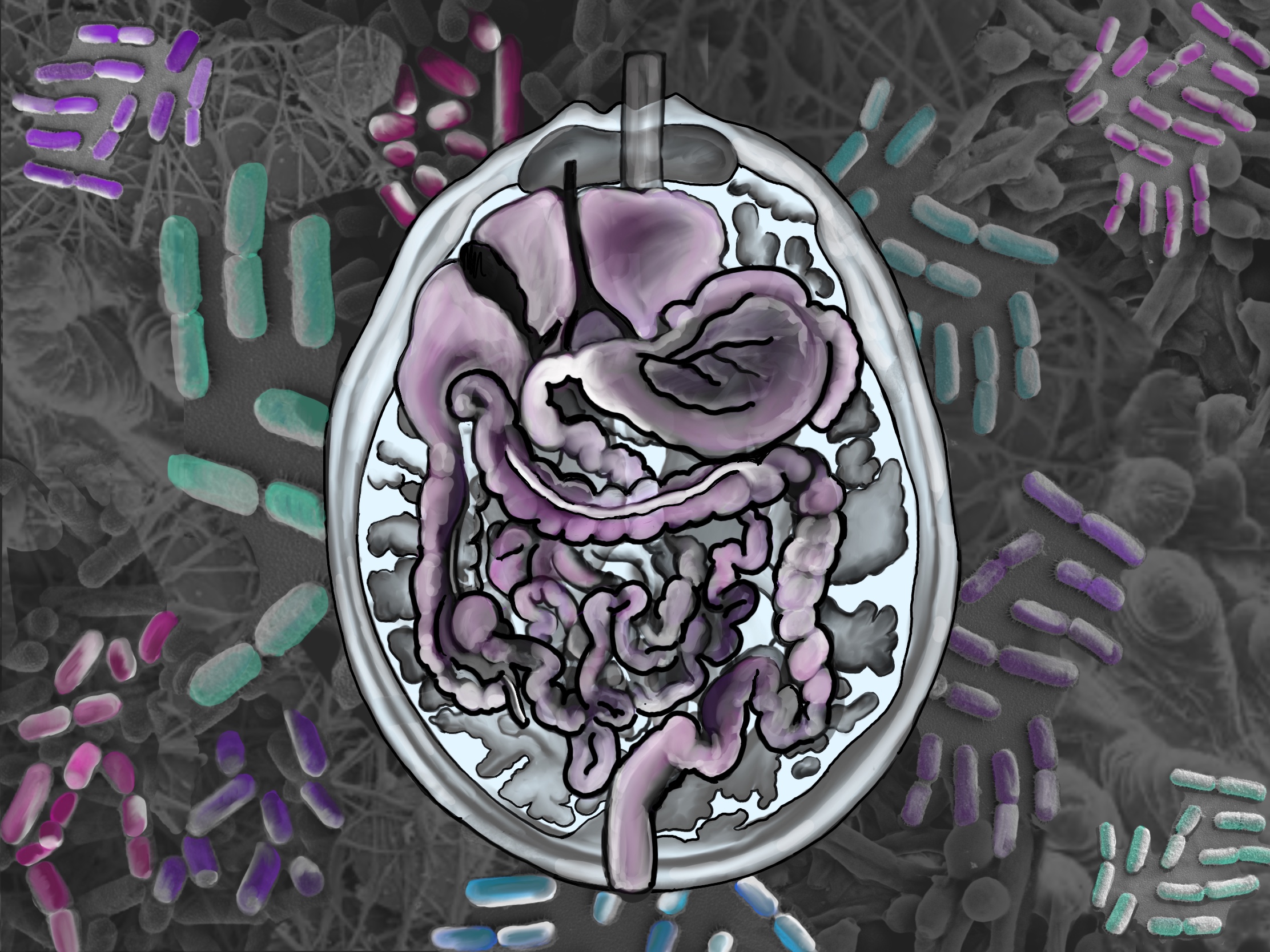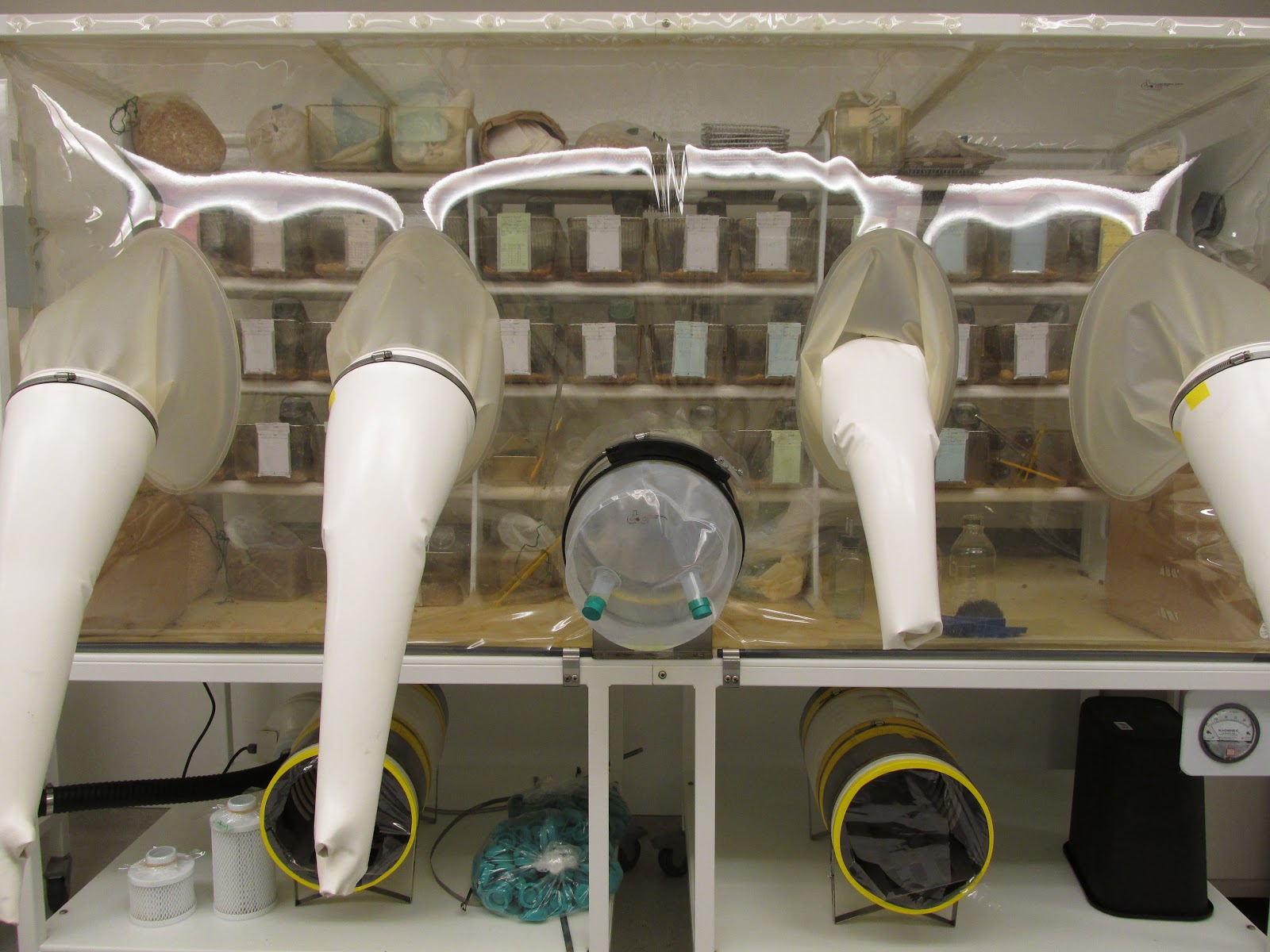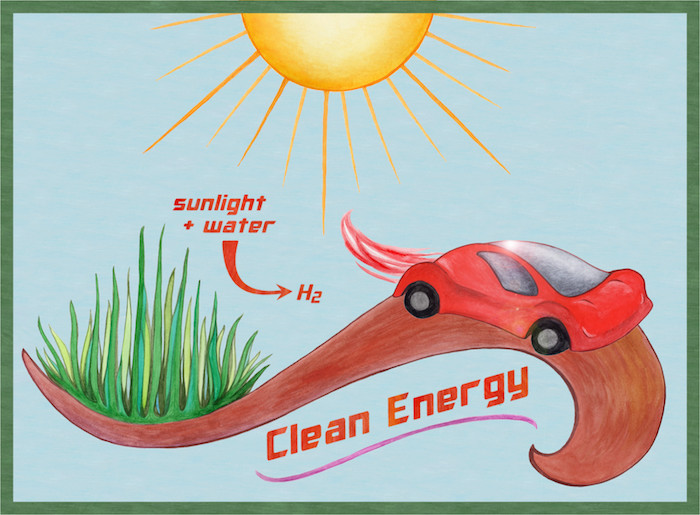
Illustration by Sarah Zeichner for Caltech Letters
Have you ever had a feeling that something wasn’t quite right, but couldn’t put your finger on it? This all too familiar sensation is commonly referred to as a “gut feeling.” Is the gut, typically associated with food and digestion, linked to our emotions and feelings? The brain is the organ that comes to mind when we think of emotions and moods. However, most of us would be surprised to learn that our digestive tract—mouth, esophagus, stomach, intestines, and anus—contains a complex network of neurons sometimes referred to as the body’s “second brain.” Communicating directly with these neurons is a vast collection of microorganisms (bacteria, viruses, fungi, etc.) collectively termed the gut microbiota. These gut bugs inhabit almost every surface of the digestive tract and we may even have nearly the same number of bacterial cells as human cells in the body. Although most people think of bacteria as harmful to our health, the good bugs that make up a vast majority of our gut microbiome exist harmoniously within us.
Phenomena like a gut feeling or butterflies in your stomach have inspired research into communication between the gut microbiota and the brain. Several early studies have shown that there is a constant stream of communication between the two. Communication between our gut bugs and brain cells is required for normal brain development and regulates changes in our mood and behavior. The notion that tiny microorganisms in our gut have the potential to impact how we think and feel probably sounds far-fetched. However, there are actually multiple avenues of communication between our gut and brain. For example, gut bacteria produce hormones and other signaling molecules, like neurotransmitters, that can relay messages to the brain. Serotonin and dopamine, the so-called “feel-good” neurotransmitters, are made by gut bacteria and influence how we think and feel. Maintaining a healthy and diverse repertoire of gut bacteria is critical for proper production of these compounds and our overall brain health.
Today, most of the evidence connecting gut microbes to our brain comes from research studies using mice. A few universities and research centers around the world, including Caltech, have special facilities for investigating the effects of the gut microbiota on brain development and function in “germ-free” (GF) mice. Unlike typical lab mice, GF mice do not have any microorganisms living on or inside any part of their body, including the gut. They spend their entire lives in sterile, giant bubbles called isolators to prevent exposure to microbes in the outside world. GF mice cannot be visually distinguished from non-GF mice, but they are far from normal. The lack of gut microbiota causes GF mice to have abnormally developed brains, and they are generally stressed and less social.

Caltech is one of the few universities with a germ-free animal facility. Germ-free mice are raised and born in plastic “bubbles” in order to remain sterile. They receive sterile food, water, bedding, and cages and fecal samples of these mice are frequently screened to confirm absence of any microbial life.
Caltech
Using this research paradigm, scientists can explore the extent to which the microbiota contributes to the onset of specific brain diseases. Since GF mice have a clean microbial slate, scientists can perform “microbiome transplants” by giving a mouse the microbiome from a person diagnosed with a specific neurological condition such as depression, schizophrenia, autism, or Parkinson’s disease. Remarkably, mice receiving microbiome transplants developed symptoms of each respective condition. It may seem implausible that a mouse can demonstrate signs of depression or other “uniquely human” conditions. However, behavioral tests show that mice have complex mental states and moods that scientists can turn into data. For example, scientists measure the propensity of a mouse to explore new environments and interact socially with other mice. Results from these tests can be an indicator of depressed or elevated mood. While mice cannot completely mirror the intricacies of human psychology, they remain an invaluable tool in the gut-brain research community.
Recently, scientists have begun to investigate the link between the gut microbiota and brain disorders in humans. While we can’t raise germ-free humans, researchers can explore how the gut microbiota community varies between healthy individuals and those diagnosed with certain diseases. The human studies suggest that disruptions in the delicate balance of good to bad bacteria in our gastrointestinal (GI) tract, due to factors like poor diet or excessive antibiotic use, may play a role in many different brain diseases. While good bacteria help us break down our food and support our overall GI health, harmful bacteria can wreak havoc on our digestive systems and make us feel sick. Depletion of good bacteria combined with overgrowth of bad bacteria may also contribute to the GI symptoms that people with Parkinson’s disease, depression, and autism frequently experience. While we are making significant advances in understanding the link between disruptions in the gut and the onset of brain disease, the direction of causality remains unclear. For example, it is not known whether changes in gut bacteria contribute to brain disease, whether changes in the brain due to disease affect gut bacteria, or a combination of both.
Scientists are also exploring how we can harness the power of the gut microbiota to treat neuropsychiatric conditions, which some scientists are calling the “psychobiotics revolution.” Therapeutic interventions targeting gut microbiota can involve repopulating the gut microbiome with the bacterial species that produce the “feel-good” neurotransmitters mentioned earlier. This approach may remedy the chemical imbalance in the brain that contributes to depression and anxiety. There are several different ways you can change your microbiome and introduce beneficial bugs. One way is through taking probiotics, which involves ingesting specific strains of live bacteria delivered in foods like yogurt or kombucha or in pill form. While probiotics have become a popular health fad in the past few years, scientists like Elie Metchnikoff advocated for their use back in the early 19th century. Metchnikoff claimed intestinal health was connected to longevity and that changing the composition of the gut microbiome, through daily doses of yogurt, could potentially delay aging and improve human health. Despite the rise in popularity of probiotics, scientists are still trying to figure out which specific strains exert a positive effect on individuals with different brain conditions. Although some commercially available probiotics claim to enhance emotional well-being, the FDA has not yet approved probiotics for treatment of any type of mental illness.
For some individuals, delivering specific strains of bacteria using probiotics may not be sufficient for restoring GI or brain health. An alternative microbiome intervention that is gaining traction in the medical community is called fecal microbiota transplant (FMT). FMT should not be discussed with those with sensitive stomachs and certainly not at the dinner table. A standard FMT treatment consists of a microbiome transplant from a healthy individual to a patient with a microbiome-related illness. Delivery of the new microbiome is often in the form of swallowing a “poop pill,” containing small amounts of stool from a healthy donor. As unpleasant as that may sound, FMT treatment has shown promising results in clinical trials in patients with gastrointestinal disorders, antibiotic-resistant bacterial infections, and autism. However, FMT has yet to gain FDA approval due to the many potential safety risks associated with this treatment.
“Can we use bacteria to treat diseases?” Professor Elaine Hsiao (Caltech PhD 2012) describes how the billions of microbes that live inside of us are crucial for our health and may one day be used to treat various diseases.
National Geographic
The development of FDA-approved microbiota treatments for brain conditions will take years or even decades. While we wait, we can take advantage of the fact that we have more control over the bugs that inhabit our GI tract than you may think. One of the most effective ways to change the makeup of our gut microbiota is through changes in our diet. Microbes in our GI tract help with food digestion and nutrient absorption. Conversely, the food we eat is a major determinant of the organisms that live in us. Therefore, feeding our microbes a healthy diet can help support the growth of health-promoting bacteria. The link between our diet and our gut bugs is not an entirely new concept. Hippocrates, the father of modern medicine, is believed to have said “Let thy food be thy medicine and thy medicine be thy food,” hinting at the notion that what we eat can influence our overall well-being.
The connection between the gut microbiome, diet, and human wellness continues to be an area of interest for many researchers. New evidence is suggesting that dietary patterns can influence the composition of our gut microbiota and determine risk for neuropsychiatric conditions like depression. A “Western diet” includes high intake of red-meat, highly-processed foods, refined sugar, and low intake of fiber. This dietary pattern, common to many Americans, has been linked to increased risk of a host of microbiome-affiliated diseases, such as obesity, metabolic disorders, depression, and anxiety. While the Western diet might literally feed your short-term sugar and fat cravings, it starves the healthy microbes in your gut that can’t access energy from those foods. The result is a less diverse gut microbiome that is overrun with unhealthy bugs that cause disease.
An alternative to the Western diet is the healthier Mediterranean diet, which is rich in vegetables, fiber, seafood, and healthy fats. This diet provides our gut bacteria with the well-balanced meal it needs to complete the arduous task of supporting our gastrointestinal and brain health. Indeed, studies have reported that individuals subscribing to the Mediterranean diet have a lower risk of developing depression and Parkinson’s disease. Although many dietary studies linking diet to brain disease remain correlative, eating a healthy and well-balanced diet is likely to make your gut bugs happy and satisfied.
So next time you find yourself reaching for a chocolate bar for a mid-afternoon energy boost, consider its impact on your gut microbiota, your body’s second brain. Perhaps one day the phrase “healthy microbes, healthy mind” will be a philosophy we strive to live by.
Further Information:
- Nutritional psychiatry: Your brain on food
- The Psychobiotic Revolution: Mood, Food, and the New Science of the Gut-Brain Connection
- Psaltopoulou, Theodora, et al. “Mediterranean Diet, Stroke, Cognitive Impairment, and Depression: A Meta-Analysis.” Annals of Neurology (2013)
- Winter, Gal, et al. “Gut Microbiome and Depression: What We Know and What We Need to Know.” Reviews in the Neurosciences (2018)
- Sarkar, Amar, et al. “Psychobiotics and the Manipulation of Bacteria–Gut–Brain Signals.” Trends in Neurosciences (2016)
- Lucas, Grace. “Gut Thinking: the Gut Microbiome and Mental Health beyond the Head.” Microbial Ecology in Health and Disease (2018)
- Jacka, Felice N., et al. “Association of Western and Traditional Diets With Depression and Anxiety in Women.” American Journal of Psychiatry (2010)
- Statovci, Donjete, et al. “The Impact of Western Diet and Nutrients on the Microbiota and Immune Response at Mucosal Interfaces.” Frontiers in Immunology, vol. 8, 2017, doi:10.3389/fimmu.2017.00838.
- What is the Mediterranean Diet?




